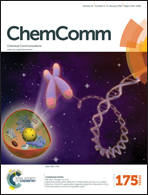Topology-guided design of an anionic bor-network for photocatalytic [Ru(bpy)3]2+ encapsulation†
Abstract
An anionic metal–organic framework, PCN-99, has been synthesized through a topology-guided strategy; its underlying bor-net is realized by the use of a tetrahedral [In(COO)4]− node and a judiciously designed trigonal planar linker. In light of its anionic nature, the inherent cuboctahedral cage and 1D channel make PCN-99 an excellent matrix to encapsulate the photocatalytic [Ru(bpy)3]2+.
![Graphical abstract: Topology-guided design of an anionic bor-network for photocatalytic [Ru(bpy)3]2+ encapsulation](/en/Image/Get?imageInfo.ImageType=GA&imageInfo.ImageIdentifier.ManuscriptID=C5CC08614K&imageInfo.ImageIdentifier.Year=2016)


 Please wait while we load your content...
Please wait while we load your content...